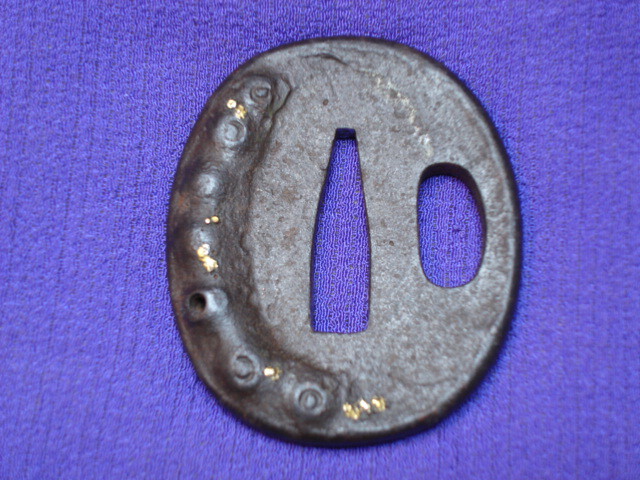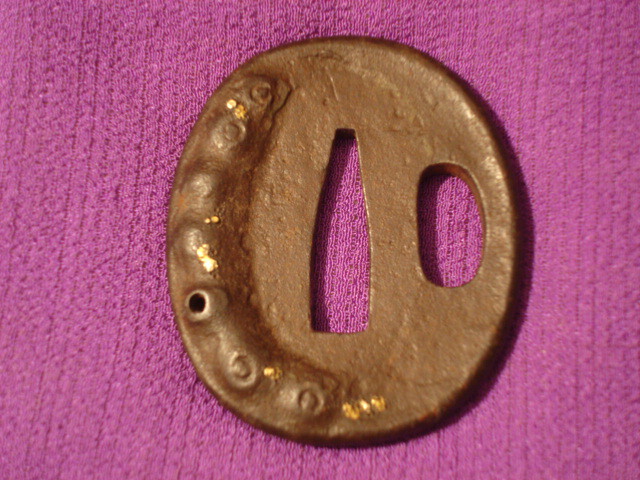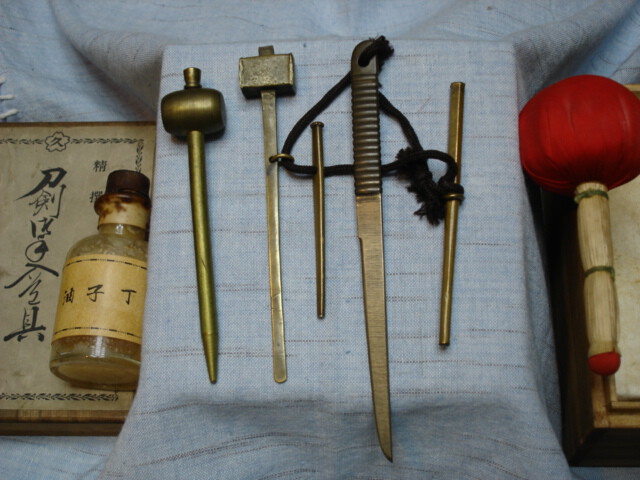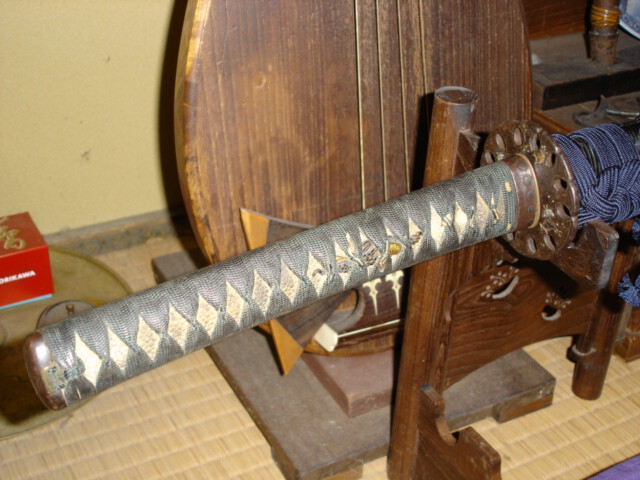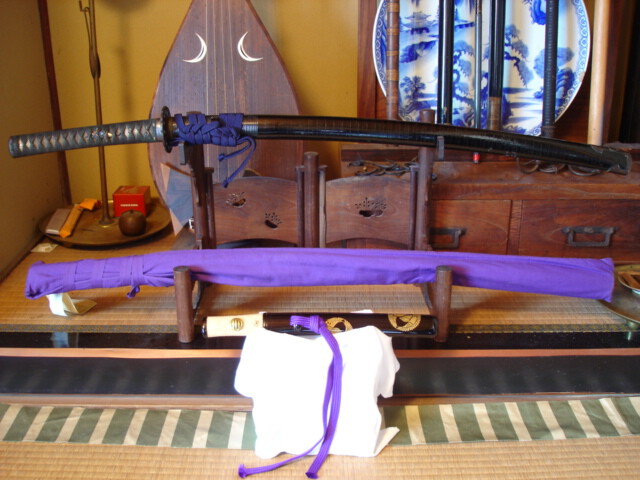-
Posts
13,166 -
Joined
-
Last visited
-
Days Won
228
Everything posted by Bugyotsuji
-
The saya is mostly the same as the paperwork except for some small detail: At the top is the name Mihara Masachika, (attribution? my comment) The next section just writes out in full NBTKH Kyokai (and a final 証 kanji to certify?) Then: Kinzogan, æ®‹æ¬ æœ‰zanketsu ari = Gold inlay, with remaining and missing (parts) The bottom section gives the length of the blade. 二尺三寸一分強 Just over 2 Shaku 3 zun (sun) 1 bu kyo PS Looking at the remains of the gold inscription, one vertical stroke between 切æ– and 山野 suggests there was another character. Then the name Yamano is offset more into a central position on the Nakago.
-
Hi Tom, Good to see you and thanks for showing us your purchase. Just a quick translation of the inscription: ç„¡å (三原æ£è¿‘) (時代室町後期) Mumei, (Mihara Masachika) (Jidai Muromachi Ko-ki) Period Latter Muromachi (金象嵌) 三ッ胴切æ– 山野__(花押) (Kinzogan) Mitsu-do setsudan, Yamano unreadable (Kao) Gold inlay, cut through three upper bodies, Yamano (___) Kao Shinsa Result: Hozon Token
-
Thank you John for your insight. This has increased the value (to me) of my birthday present to myself. I am aware that you cannot be certain and that you are prepared for someone to come on and say no for the following reasons, but it has given me something to chew on. Some of the 'incrustation' (I like that choice of word) has been lost, unfortunately. Rusting tends to lift zougan off. I suppose the exposed position on the edge of the mimi was not very practical either. This gives us a hint ... impractical = later work?)
-
OK I'll attempt the label. I hope Koichi san is not doing this at the same time! 福井県 Fukui Ken (Prefecture), 三方郡 Mikata (?) Gun (County), 南西郷村 Nansei Go Son (village), 郷市 Kyoichi/Goichi ? and the name is 楠 Kusunoki 清 Kiyo/Kiyoshi (?) *Without knowing the actual place names in Fukui Prefecture it's hard to guess the local readings. The Kanji on their own are fine as long as no-one tries to pronounce them!!! :lol:
-
Thank you the link, Ford. Very good quality and well-thought-out web page.
-
Hi all. I was given this small Mumei tetsuji tsuba for my birthday which is next week. Don't ask... It comes from a reputable major sword shop and I know the people well enough that it is not a 'fake'. No information was given with it; my primary concern is that I really like it. Looking through several books points me in the stylistic direction of Kanaie, (iron quality, hammering and furled mimi) but I am unable to narrow it down further. It is takabori and has a hammered surface. The shells on the omote mimi are done in shakudo, kin, gin, shinchu and do, in exquisite detail. The abalone volcanoes look 'punched', and one has broken through. We had a thread talking about awabi/abalone shells, and it could even have been mine, but searching hasn't pulled the right one up, otherwise I would have posted this there. The photos have been taken under two sets of lighting, one with 6 fluorescent rings, the other with just one incandescent bulb. The true color/clour is somewhere in between. Any thoughts on age, school, artist would be much appreciated. :|
-
The tag is not too difficult either. It's just the name and address of the wartime owner. Dunno what the 1500 refers to, though.
-
A good find! Thanks...
-
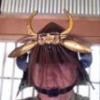
Help deciphering a Mei, Please
Bugyotsuji replied to hybridfiat's topic in Auctions and Online Sales or Sellers
Jacques. Excellent links. No more questions. Thank you. -

This Week's Edo Period Corner
Bugyotsuji replied to Bugyotsuji's topic in General Nihonto Related Discussion
Someone mentioned cleaning kits the other day. Recently I found an old kit where the oil has turned into a kind of wax or something! In the photo I have included an old Edo Period Mekugi Uchi and brass hammer. There are various bits that came with it that I have strung together. I don't know what the brass blade is for, but it doesn't appear to be so old. Likewise the other rounded hammer is probably less than 70 years old. -

This Week's Edo Period Corner
Bugyotsuji replied to Bugyotsuji's topic in General Nihonto Related Discussion
I was looking at a sword in a museum today that recorded in the Mei that it had cut through two dead bodies at Tameshigiri. This reminded me of your picture above. The sword would not just find the right place between the joints, but would cut right through the bones! Van Gogh also collected Chirimen-e when they were simply Ukiyo-e that had been minutely folded into a kind of crepe and used as packing for tea containers. -
Today I was watching a deshi finishing off a black urushi saya at an urushi nuri workshop and thinking about asking him to look at my saya. Too many people crowded around so I gave up. (Some time ago, I stepped back when changing out of armour/armor and I heard a crunching sound under my heel) Asking someone to do it perfectly for you would be one way, but it might prove expensive.
-
Why don't you ask the NTHK directly about their "kinsei" attribution? And while you're at it, tell them to fire the guy who writes Japanese like a first-grader .... Too right! Or... who writes Japanese like a Western learner! LOL at Guido. :lol:
-

Help deciphering a Mei, Please
Bugyotsuji replied to hybridfiat's topic in Auctions and Online Sales or Sellers
There seem to be three readings of this name, but I am not sure which is the 'accepted' correct one. Is it 1. Rai Kinmichi, 2. Rai Kanemichi or 3. Rai Kindo? My first instinct was no 2. Kanemichi for the sound, which doesn't mix On and Kun readings. But then I found a reference to 3. Kindo, which keeps true to the On reading of Rai; this also seemed good. Finally I found a reference quoting all three readings and thus decided to post the question. -

This Week's Edo Period Corner
Bugyotsuji replied to Bugyotsuji's topic in General Nihonto Related Discussion
That's a gorgeous manju Netsuke there, Eric. All of what you say rings true. What slightly puzzles me is how the section of ivory signed by Masamitsu (my first impression was how similar the Mei was to a Netsuke-shi) with that scene could have been independently created. Unimaginable in Japan as a stand-alone object. It must have been an order from Europe. The lost wax decoration by Barbedienne would have been added later, but can you be sure that they never met, or never cooperated? -
Good to see you here, Andrew. My eye is completely untrained, but that looks like a good solid blade, and you may have got a bargain. I suspect that the chip has knocked the price out of that. A very good start to your studies. I bought my koshirae separately and had the sori of the saya adjusted for it.
-

This Week's Edo Period Corner
Bugyotsuji replied to Bugyotsuji's topic in General Nihonto Related Discussion
Which one? (There are in fact some glitches due to them converting my Japanese fonts into Chinese fonts, but I don't see any in this particular description.) Takanashi should be Takahashi -

This Week's Edo Period Corner
Bugyotsuji replied to Bugyotsuji's topic in General Nihonto Related Discussion
Ian, are you left-handed, or is that a quirk of Daguerrotypes? :lol: -

This Week's Edo Period Corner
Bugyotsuji replied to Bugyotsuji's topic in General Nihonto Related Discussion
Sorry Eric, your post got swept away in the subsequent flow of daisho postings. This is a vase? Does it have a waterproof container inside? That is one massive section of ivory from a noble elephant it would seem. It is such a curious mixture of styles, very Napoleonic(?) and it looks quite valuable. What do you know about Masamitsu and Barbedienne? They must have known each other and cooperated together at some known point in time. -

This Week's Edo Period Corner
Bugyotsuji replied to Bugyotsuji's topic in General Nihonto Related Discussion
I don't have anything comparable, but my katana-kake is a folding type and can hold up to five swords. I usually put the katana koshirae, and my boku-to and iai-to on it. -

This Week's Edo Period Corner
Bugyotsuji replied to Bugyotsuji's topic in General Nihonto Related Discussion
It has a late Kamakura period Aoe blade (but not in the Koshirae). Some classify Aoe as Bizen-den, others [including me] as Yamashiro-den. Btw, it's first sword on this page http://www.arscives.com/historysteel/japanese_swordlist.htm from the "History of Steel" exhibition in Macau. That too was very instructive. Mmmm... Yamashiro-den. I didn't know anything about Aoe until today, even living here in Okayama on the Asahi, right between the Yoshii and Takahashi rivers. I'm going to find out what I can. (By the way, there is a small spelling mistake on the site where it gives Takanashi for the river name.) -

This Week's Edo Period Corner
Bugyotsuji replied to Bugyotsuji's topic in General Nihonto Related Discussion
Guido, thank you for posting that link to your earlier project. Lovely swords, and a very interesting explanation. I particularly like the long kissaki on your wakizashi. A beautiful polish has revealed such workings in their blades. Again I see how much I don't know, and how much there is yet to learn. As to the placing of the tsuka on the kake, you make a good point about the blades being in shirasaya, and thus no danger with a tsunagi in the koshirae. Even with a blade in place, it should be locked to hang in midair inside the saya. Perhaps it is the aesthetic in me which winces when I see for example the photo of the tanto on the previous page. Unfortunately you have now whetted my appetite for a closer association with Nihonto, namely the desire to possess something really beautiful and to be able to look after it and appreciate it as it deserves. But I am not ready yet. -

This Week's Edo Period Corner
Bugyotsuji replied to Bugyotsuji's topic in General Nihonto Related Discussion
There was a similar question in the following therad. viewtopic.php?f=1&t=1603 Thank you Koichi sama. That was back before I was born!!! So, it's perfectly all right to rest the katana on the tsuka if the stand is too wide. -

This Week's Edo Period Corner
Bugyotsuji replied to Bugyotsuji's topic in General Nihonto Related Discussion
Holy Mackerel! Look at those, and yours are matching colours too. Oh, no, how am I going to keep face around here? *Quick question there Guido. You don't rest the wakizashi on its tsuka, whereas Eric does. I've watched carefully in Japan and seen both on many occasions, but my sense of what? mechanics? tells me it should rest on the saya, not on the tsuka, so that the blade is less likely to move inside the saya in an earthquake or something. Never asked anyone, but is there a saho about this at all, would anyone know? :| -

This Week's Edo Period Corner
Bugyotsuji replied to Bugyotsuji's topic in General Nihonto Related Discussion
Yes, I see what you mean. The sori of the black saya are picked up by the hills in the picture. Quite clever. Thank you for showing those. Is that a low ceiling or a cabinet roof? Now I am beginning to imagine how good it would be to own a pair of daisho. I used to toy with the idea of dai-chu-sho; having one katana, one wakizashi and one tanto and absolutely no more, not necessarily matching. I had a lovely shirasaya wakizashi, but in a fit of pique I went and sold it.


